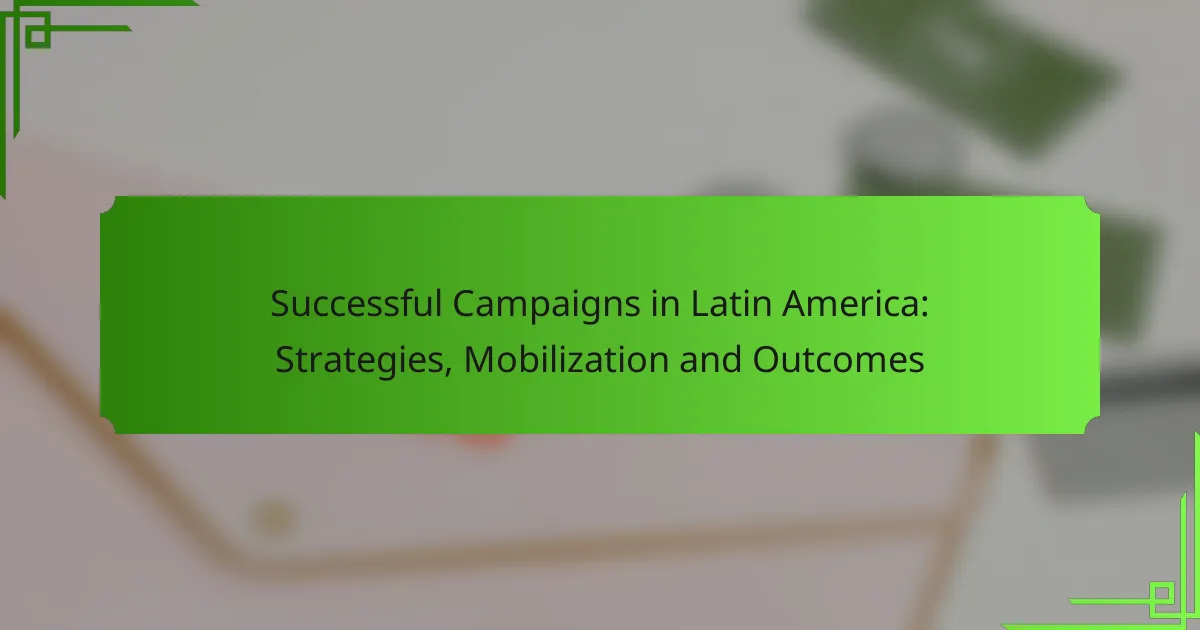Successful campaigns in Latin America are characterized by strategies that resonate deeply with local cultures and values, utilizing localized messaging and digital engagement. By prioritizing community involvement and grassroots initiatives, organizations can foster trust and build strong networks. The measurable outcomes of these campaigns, such as increased brand awareness and engagement rates, highlight the effectiveness of tailored marketing approaches in the region.

What are the key strategies for successful campaigns in Latin America?
Successful campaigns in Latin America rely on tailored strategies that resonate with local cultures and values. Key approaches include localized messaging, digital engagement, partnerships with influencers, effective use of social media, and data-driven decision making.
Localized messaging
Localized messaging is essential for connecting with diverse audiences across Latin America. Campaigns should reflect local languages, cultural references, and regional issues to foster relatability and trust.
For example, using colloquial expressions or addressing community-specific concerns can significantly enhance engagement. Tailoring messages to reflect local customs and traditions can make a campaign more impactful.
Digital engagement tactics
Digital engagement tactics are crucial for reaching a tech-savvy audience in Latin America. Utilizing email marketing, mobile apps, and interactive content can enhance user participation and brand loyalty.
Consider employing gamification strategies or contests that encourage user-generated content. These tactics not only boost engagement but also create a sense of community among participants.
Partnerships with local influencers
Collaborating with local influencers can amplify a campaign’s reach and credibility. Influencers often have established trust with their followers, making their endorsements valuable.
Choose influencers whose values align with your campaign to ensure authenticity. Micro-influencers, who typically have smaller but highly engaged audiences, can be particularly effective in niche markets.
Utilizing social media platforms
Social media platforms are vital for successful campaigns in Latin America, where usage rates are high. Platforms like Facebook, Instagram, and TikTok can be leveraged to share content and engage with audiences directly.
Each platform has unique features; for instance, Instagram Stories can be used for real-time updates, while Facebook Groups can foster community discussions. Tailoring content to fit the platform’s strengths can enhance visibility and interaction.
Data-driven decision making
Data-driven decision making is critical for optimizing campaign strategies in Latin America. Analyzing metrics such as engagement rates, conversion rates, and audience demographics can provide insights into what works best.
Utilize tools like Google Analytics or social media insights to track performance. Regularly reviewing this data allows for adjustments in real-time, ensuring that campaigns remain relevant and effective.

How can organizations mobilize effectively in Latin America?
Organizations can mobilize effectively in Latin America by focusing on community engagement, grassroots efforts, and local events. These strategies foster trust, build networks, and create a sense of ownership among participants, which are crucial for successful campaigns.
Community involvement initiatives
Community involvement initiatives are essential for fostering local support and participation. Organizations should prioritize building relationships with community leaders and stakeholders to understand local needs and values. This can include workshops, focus groups, or collaborative projects that address specific community issues.
Effective initiatives often leverage local resources and knowledge, ensuring that solutions are culturally relevant and sustainable. For example, partnering with local NGOs can enhance credibility and reach, while also providing valuable insights into community dynamics.
Grassroots organizing
Grassroots organizing focuses on mobilizing individuals at the local level to drive change from the bottom up. This approach often involves recruiting volunteers who are passionate about the cause and can engage their networks. Training these volunteers in advocacy and communication skills is vital for amplifying their impact.
Successful grassroots efforts typically utilize social media and community meetings to spread awareness and gather support. Organizations should be prepared to adapt their strategies based on feedback and the evolving landscape of community needs.
Leveraging local events
Leveraging local events can significantly enhance mobilization efforts by tapping into existing community gatherings. Organizations should participate in or sponsor festivals, markets, or public forums to raise awareness and connect with potential supporters. This visibility can help build rapport and trust within the community.
When planning to leverage events, consider aligning the campaign message with the themes of the event to ensure relevance. For instance, a health campaign could tie into a local health fair, providing free screenings or educational materials that resonate with attendees’ interests.

What are the measurable outcomes of successful campaigns?
Successful campaigns in Latin America yield several measurable outcomes, including increased brand awareness, higher engagement rates, and sales growth. These outcomes can be quantified through various metrics, allowing businesses to assess the effectiveness of their marketing strategies.
Increased brand awareness
Increased brand awareness refers to the extent to which consumers recognize and remember a brand. Successful campaigns often employ targeted advertising, social media outreach, and influencer partnerships to enhance visibility. Metrics such as reach, impressions, and social media mentions can help quantify this awareness.
For example, a campaign that utilizes local influencers in Brazil may see a significant uptick in brand mentions on social platforms, indicating heightened awareness among target demographics. Tracking these metrics regularly allows brands to adjust their strategies for optimal impact.
Higher engagement rates
Higher engagement rates reflect the level of interaction consumers have with a brand’s content. This can include likes, shares, comments, and click-through rates on digital platforms. Engaging content tailored to local cultures and preferences can significantly boost these rates.
For instance, a campaign in Mexico that incorporates local festivals or traditions into its messaging may experience increased interactions compared to generic content. Monitoring engagement metrics helps brands understand what resonates with their audience and refine their approach accordingly.
Sales growth
Sales growth is a direct outcome of successful campaigns, indicating an increase in revenue generated from products or services. Effective campaigns often lead to higher conversion rates, translating engagement into actual sales. Businesses should track sales data before, during, and after a campaign to measure its impact accurately.
In Argentina, for example, a promotional campaign that offers discounts during a holiday season can lead to a noticeable spike in sales. Analyzing sales trends can help brands identify successful tactics and replicate them in future campaigns for sustained growth.

What are the challenges faced in Latin American campaigns?
Campaigns in Latin America encounter various challenges that can hinder their effectiveness. Key obstacles include cultural diversity, regulatory hurdles, and economic fluctuations, each requiring tailored strategies for successful mobilization and outcomes.
Cultural diversity
Cultural diversity in Latin America presents both opportunities and challenges for campaigns. With numerous languages, traditions, and social norms, understanding local contexts is crucial for resonating with target audiences. Campaigns must adapt messaging and strategies to reflect regional differences, ensuring inclusivity and relevance.
For instance, a campaign that works in urban areas may not be effective in rural communities due to differing values and communication styles. Engaging local influencers can help bridge these gaps and enhance credibility.
Regulatory hurdles
Regulatory hurdles can significantly impact campaign execution in Latin America. Each country has its own set of laws governing advertising, political campaigning, and data protection, which can vary widely. Campaigns must navigate these regulations to avoid legal issues and ensure compliance.
For example, some countries may require specific disclosures in advertising or limit the types of data that can be collected from consumers. Familiarizing oneself with local laws and consulting legal experts can help mitigate risks associated with non-compliance.
Economic fluctuations
Economic fluctuations in Latin America can affect campaign budgets and consumer behavior. Changes in currency value, inflation rates, and economic stability can impact funding availability and audience spending power. Campaigns need to be adaptable to shifting economic conditions to maintain effectiveness.
For instance, during economic downturns, consumers may prioritize essential goods over luxury items, necessitating a shift in campaign focus. Monitoring economic indicators and adjusting strategies accordingly can help campaigns remain relevant and effective in varying economic climates.

What frameworks can guide campaign planning in Latin America?
Campaign planning in Latin America can be effectively guided by frameworks such as SWOT analysis and stakeholder mapping. These tools help identify strengths, weaknesses, opportunities, threats, and key players in the campaign landscape, ensuring a strategic approach to mobilization and outcomes.
SWOT analysis
SWOT analysis involves evaluating the internal strengths and weaknesses of a campaign, alongside external opportunities and threats. For example, a campaign may leverage strong community support (strength) while facing limited funding (weakness). Identifying opportunities like emerging social media trends and threats such as political opposition can shape strategic decisions.
To conduct a SWOT analysis, gather a diverse team to brainstorm each quadrant. Focus on actionable insights, such as how to capitalize on strengths or mitigate weaknesses. Regularly revisit the analysis as conditions change, ensuring the campaign remains responsive to the evolving landscape.
Stakeholder mapping
Stakeholder mapping identifies and prioritizes individuals or groups that can influence or are affected by the campaign. This process helps in understanding their interests, power dynamics, and potential impact on the campaign’s success. For instance, local government officials may have significant influence over policy changes, while community leaders can mobilize grassroots support.
To effectively map stakeholders, create a visual representation that categorizes them by influence and interest. Engage with high-priority stakeholders early to build alliances and address concerns. Regularly update the map to reflect changes in stakeholder positions or new emerging players in the campaign environment.

How do successful campaigns adapt to local markets?
Successful campaigns in Latin America tailor their strategies to align with local cultures, preferences, and economic conditions. This involves understanding regional nuances, engaging with community values, and leveraging local channels for communication and mobilization.
Understanding Cultural Nuances
Adapting to cultural nuances is crucial for campaign success. This means recognizing local traditions, languages, and social norms that influence consumer behavior. For example, campaigns that incorporate local dialects or cultural symbols often resonate more deeply with the audience.
Engagement with local influencers can also enhance credibility and relatability. Collaborating with figures who embody local values can amplify the campaign’s message and foster trust among potential supporters.
Leveraging Local Media Channels
Utilizing local media channels is essential for effective outreach. This includes traditional media such as radio and television, as well as social media platforms popular in specific regions. Tailoring content to fit the preferred platforms of the target demographic can significantly increase engagement.
For instance, in countries where WhatsApp is widely used, campaigns can benefit from creating shareable content that encourages word-of-mouth promotion. Understanding the local media landscape helps in selecting the right channels for maximum impact.
Engaging with Community Values
Successful campaigns resonate with community values by addressing local issues and concerns. This requires thorough research to identify what matters most to the target audience, such as economic stability, education, or health care access.
Campaigns that demonstrate a commitment to social responsibility and community development often gain stronger support. Initiatives that involve local stakeholders in decision-making processes can enhance community buy-in and participation.
Measuring and Adapting Strategies
Continuous measurement and adaptation of strategies are vital for campaign success. Utilizing metrics such as engagement rates, conversion rates, and feedback from local audiences can inform necessary adjustments. This iterative approach allows campaigns to remain relevant and effective.
Implementing A/B testing for different messages or channels can provide insights into what resonates best with the audience. Regularly reviewing campaign performance ensures that strategies align with evolving local market dynamics.
